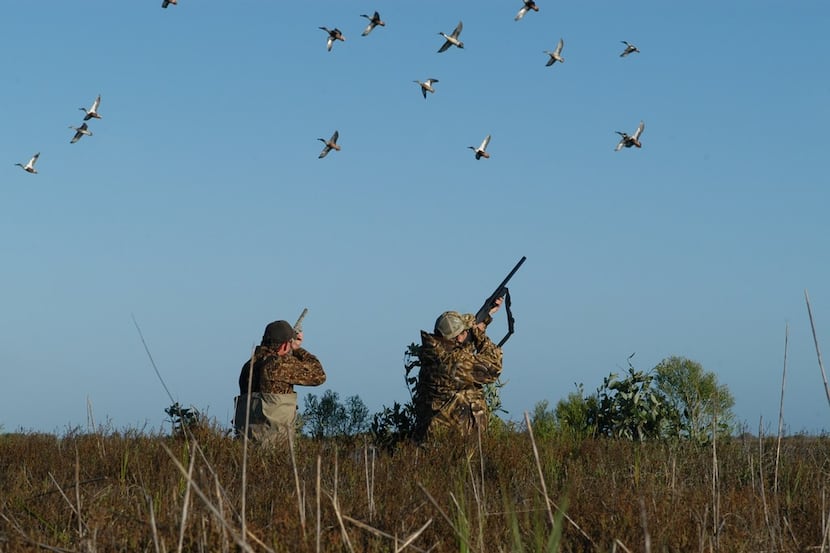If America is the land of opportunity, then it might be fitting to call Texas the land of happy hunting. It's a sportsman's mecca, ripe with all sorts of wild game to provide the state's army of 1 million-plus hunters with plenty of excuses to get outside and stock up on a variety of meat that is just as good for you as it is tasty to eat.
While white-tailed deer rank as the state's most popular game animal, annually attracting around 700,000 resident hunters to the field, smaller legions of hunters are just as passionate about hunting quail, turkey, squirrel, ducks, geese, pheasant and other small game.
Texas' small game hunters bag plenty of limits, too.
To wit: Last year, nearly 667,000 small game hunters in Texas shot a combined total of more than 10.2 million doves, ducks, geese, quail, rabbits, snipe, squirrel, teal, turkey and pheasants, according to the Texas Parks and Wildlife Department's Small Game Harvest Survey. The annual survey tracks hunter and harvest trends for 23 species and/or seasons of upland and migratory game animals.
Just about every hunting season is a good one in Texas, but some always play out better than others for small game hunters. Here's a summary of what the prospects look like for quail, turkey and duck hunters this year:
Quail
Quail are resilient little birds prone to boom and bust cycles spurred by wild swings in weather and habitat. Good conditions in winter, spring and summer can lead to bevies of bobwhites in the field when fall hunting season rolls around. Just the opposite happens when conditions are not so favorable.
TPWD upland bird program leader Robert Perez says things are setting up for a spotty season across much of the Rolling Plains, South Texas and the Gulf Coastal Prairies.
"This past winter was exceptionally dry across all of these areas, especially in the Rolling Plains, where some places went without any precipitation for 100 consecutive days," he said. "Unfortunately, these conditions can reduce the availability of foods like winter greens, which are needed to get quail into breeding condition. Spring was also dry over much of these areas with few exceptions. Fortunately, quail are opportunistic when it comes to the breeding/nesting season and can take advantage of the rains even if they come late like they did this summer."
Rolling Plains: Perez says the northeast Panhandle and the area around Abilene are showing the most promise, whereas dry conditions hampered reproduction around the central Panhandle from Paducah to west of Lubbock.
"There will likely be some good hunting opportunities where good habitat and rainfall overlap," he said. "It is looking like an average to slightly below average year, depending on how well the late summer broods hold on."
South Texas: Perez said areas around Hondo, Sabinal and Knippa are in good shape thanks to timely summer rains. "We're hearing reports of good-sized broods and multiple age classes in that area," he said.
It's a different story in the western half of the region, where late summer rains were not enough to offset July high temperatures. Perez noted that the Coastal Sand Plain has fared better than areas further from the coast.
Gulf Coastal Prairies: Perez said rains in late June and July may have stifled early nesting activity around Goliad, Refugio and Victoria, where small areas of native prairie remain. "Unlike the other regions, too much summer rain can be a problem on the coast, where flooding can destroy nests and lower chick survival," he said.
Wild Turkey
Rio Grande turkey: TPWD wild turkey program leader Jason Hardin said the dry and hot conditions that persisted across most of the Rio Grande turkey range last spring and early summer likely resulted in limited production and recruitment of young birds into fall.
"There are always exceptions and some areas will see some recruitment, but it will be limited," Hardin said. "Fortunately, we had excellent production and recruitment across almost the entire Rio Grande range in 2015 and 2016, which has resulted in a good number of mature birds. We only had limited reproduction and recruitment in 2017 despite favorable moisture, but that is still contributing to good turkey numbers."
Eastern wild turkey: Althougheastern turkey populations continue to struggle, Hardin has been encouraged by recruitment data collected on some "super stocking" sites. Super stockings are carried out at select sites using 80 wild trapped birds (20 gobblers/60 hens) purchased from other states.
"We saw a ton of poults recruited in the population at our 2017 super stocking site in Anderson County," Hardin said. "We are also recording a good number of poults on one of our 2018 super stockings and we continue to see young birds in the population at most of our other super stocking sites. We have plans to release another 80 eastern wild turkeys at a site in Henderson County this winter."
Ducks
TPWD waterfowl program leader Kevin Kraai was optimistic about the upcoming waterfowl season, despite a 13 percent dip in duck numbers reflected by the 2018 Waterfowl Population Status Report recently released by the U.S. Fish and Wildlife Service.
"Albeit that we did see declines in almost all species of ducks this year, we are just two years removed from the highest index ever recorded and way above the long term average for total ducks except two species [pintails and scaup]," Kraai said.
Kraai noted that this year's survey showed the 12th-highest duck index on record since 1955.
Kraai also pointed out that big numbers of ducks don't mean much for Texas hunting without food and water to hold the birds once they arrive.
"Duck numbers are only part of the equation for successful waterfowling here in Texas," Kraai said. "Much of the state was experiencing significant moisture deficiencies this spring and early summer, but habitat conditions improved in late summer."
Matt Williams is a freelance writer based in Nacogdoches. He can be reached by e-mail at attwillwrite4u@yahoo.com.
